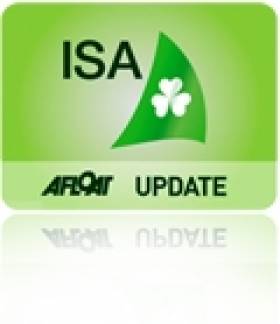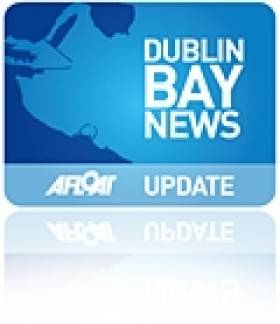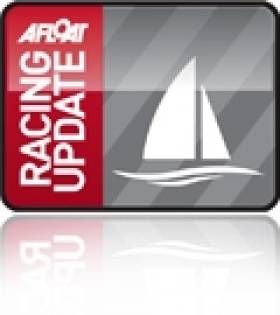Displaying items by tag: j80
Team Echo Win Dublin Match Race Event
After a three round robin series organised by Howth Yacht Club, visting Team Echo, from Poole in Dorest, won Dublin's 2011 Match Racing Open. The team made up of Mark Lees, Toby Yeabsley, Mark Yeabsley and Peter Austin convincingly won the Investwise sponsored series, sailed in J80s with 11 wins and one loss.
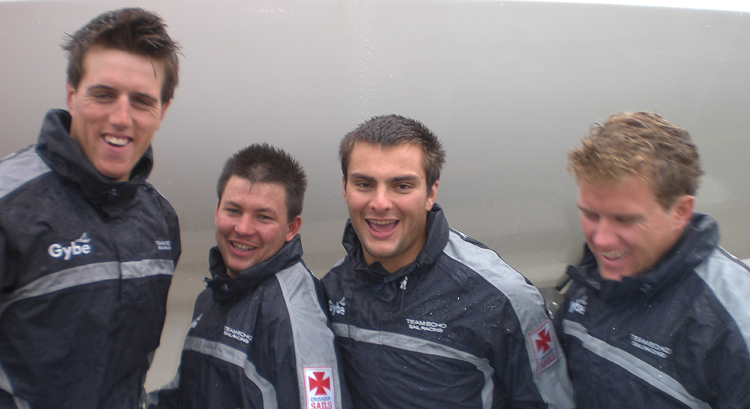
Team Echo won the Dublin Match Racing Open
In the second race an unfortunate incident where bowman Peter Austin cut his leg disrupted the usual momentum of the team. an Irish Match racer kindly stepped in as a substitute for the remainder of racing one the first day and regular mainsheet trimmer Toby Yeabsley stepped in as bowman while Peter went to be treated in hospital.
A tie break was required to split the home clubs team - consisting of evelopment squad members skippered by Ryan Scott - from Peter Bayly and Team PN, with the HYC Development Squad taking second 2 wins to 1. Peter showed glimpses of what he can do, the only skipper to take a race form the British team.
Alistair Kissane and Team Pies finished fourth and Audrey Adamson with SailingWest Ladies finished fifth.

RStGYC Celebrate First Ever Family Regatta
The first-ever RStGYC J80 Family Regatta took place on Sunday June 19. The wind and weather Gods smiled on us for a change as a big gathering of families congregated on the new Quarterdeck for Briefing and boat allocation. PHOTOS BELOW.
It was super to see such a great turnout (17 familes) and an extraordinary span of ages from about one year up to the elderberry Kirwan, Captain Paddy. Indeed, the Kirwan team had no less than four generations onboard!
Racing was in two flights in the 8 ISA Sailfleet J80s, with changeover by RIB co-ordinated by our Junior Organiser Adrian Eggers. Younger sailors ashore were kept busy by the inflatable bungee-run whilst the adults and youths nattered, drank coffee and chilled out. After racing, all enjoyed one of those increasingly popular Quarterdeck BBQs.
The first flight set off from the Marina's West Bight and turned left into Seapoint Bay. There was a nice Force 3-4 with flattish water, vital for those on-the-water changeovers! We tucked the course in a bit to leave plenty of room for the Flying Fifteen Nationals taking place further up towards Sandymount and to give the SB3s the rest of the Bay for their afternoon racing. The short course helped keep things interesting.
Each flight had three races and all six had really close racing. The standard was prety hot too, with the fleet hitting the start line pretty much bang-on and up to 6 boats rounding certain marks together. The ISA bosun was with us onboard the Flagship and while he definitely looked away a few times, he was very impressed with the boathandling on display. Indeed the skills shown by some of our young sailors, whether on the helm or crewing for their "old pairs" was really great to watch. Such naturals !!
A few prizes were dished out afterwards but the old cliché was never truer ; everybody who took part was a winner. Many thanks to the RIB crews and staff who helped make things run smoothly both on and off the water, especially Ronan Adams, our Sailing Manager. Let's not forget the 8 generous sponsors of the J80s too ; The Examiner, Smyths Toys, KPMG, McCann Fitzgerald, Smart Telecom, DynoRod, Dun Laoghaire Marina and O'Leary Insurances. The Royal St George YC is proud to be a Sailfleet founder member club. It's also only fair to mention that these boats are kept in fantastic condition, despite four years of heavy use up and down the country. Shame there aren't any big grants left !
The 17 RStGYC families sailing the J80s were (in no particular order) ; MacManus, Lyttle, O'Beirne, O'Connor (John), Hyland, O'Keefe-Pettitt, O'Connor (Gerry), Gilmer, Deladienee, Fogarty, O'Connell, Kirwan, Foley, Cahill, Walsh, Cooke, O'Connor (Richard).
Howth Yacht Club Lays Out 2011 Sailing Programme
At a launch reception in the club on Thursday 31st March attended by representatives of local commerce, tourism and community bodies, HYC Commodore Roger Cagney announced that in addition to junior and adult sail training courses and club racing four days a week in the summer months, the Club would host over 20 open events during the year.
"We are used to sailing being a year-round activity," he said, "but even by our standards this will be an exceptionally busy year for Howth Yacht Club. We are fortunate in the number of talented volunteers we can call upon to help make these events successful and we have an enviable track record in this regard. We are also extremely grateful for the sponsorship of individual events from commercial concerns, details of which will be released in due course."
The major event on the 2011 calendar is undoubtedly the European Championship of the J24 Class, the world's most popular racing keelboat, when over 200 sailors from six or more countries will compete in the four-day regatta in September.
Howth will also host the Irish Championships of four classes – Puppeteer, Squib, Howth 17 and Optimist – between July 1st and late-August, with the latter attracting up to 200 competitors, together with their families, coaches and supporters. In addition, HYC will run the SB3 Eastern Championships (end April), the RS Feva Leinsters (late May) and the Dublin Match Racing Open (in J80s in early September).
The club's programme also comprises the Spring Warmer series in April, the annual Lambay Races on June 11th, the Dinghy Regatta a week later and the ever-popular Autumn League over five weekends in September/October.
All Ireland Champs Move to Kinsale
The re-run of the All Ireland Sailing Championships will take place in Kinsale and not Crosshaven on November 20th according to a press release from the Irish Sailing Association published today.
A minimum of three races must be completed for the competition to conclude and the ISA Helmsman's Trophy awarded.
The final, originally scheduled to take place in Royal Cork Yacht Club on the 26th of September, had to be abandoned due to an absence of wind.
The competition will be sailed in the ISA SailFleet J80's which are currently based in Kinsale Yacht Club. Due to the difficulty in safely sailing the fleet from Kinsale to Crosshaven the venue had to be changed, however the host club remains Royal Cork Yacht Club who are now kindly assisted by Kinsale Yacht Club.
8 teams will be competing for the ISA Helmsmans Trophy. As this competition is recognised as a new event, no previous points shall be carried forward. Each competitor begins with a blank score card.
The finalists are:
Anthony O'Leary
Ewen Barry
Garrett May
James Espey
Neil Kenefick
Niall Henry
Nicholas O'Leary
Nick Walsh
Who'll win? We're starting a readers poll on Monday. Click back to cast your vote!
Cork Institute of Technology Win 2010 Student Yachting Nationals
Last weekend saw the Student Yachting Nationals take place at the Royal Cork Yacht Club. The students had the use of the ISA J80 Sailfleet for the event. Six college teams entered for the Nationals which was the Qualifier for the Student Yachting World Cup 2011.
Racing was scheduled for Cuskinny on Friday and conditions were ideal with 17-20 knots of breeze. Race Officer, Nathan Kirwan, got in four good races lasting some 40 to 50 minutes each. However, spinnakers were banned as some wipeouts had been observed by the ISA Bosun who exercised his judgment in this regard. Some two minutes after the start of the first race UCC skippered by Robert O'Leary suffered a snapped halyard but were refused redress. CIT skippered by George Kenefick lost their only winch handle overboard some three minutes before the start in race 1 but still managed to win the race by a comfortable margin. In race 2 UCC came back strongly to take the gun and pushing CIT into second place. At this stage match racing had begun between the two Cork colleges with each throwing dummy tacks to try to clear their air. In Race 3 TCD skippered by Alistair Kissane took the win with CIT in second and UCC third. The final race of the day was won by CIT with UCC third. Overall standings for Day One were: CIT 6pts, with UCC and TCD on 12 pts each. UCD had got off to a shaky start which was to prove costly for them as they were on form on days two and three.
On day two the Race Officer moved the course to the Curlane Bank and spinnakers were permitted. CIT found their rythym taking the bullet in race 5 with UCD in second and a poor mark rounding relegated UCC to third place. Race 6 saw the O'Leary and Kenefick teams doing circles at the pre start as the competition was intensifying and it was looking like a two horse race. UCC took first place with NUIG taking second and CIT third. Donagh Good of CIT went for a quick dip in the cold water but managed to grab on and was pulled back on board by George Kenefick and Kevin Goulding. Later during day 2 the wind was rising to 22 knots so spinnakers were once again banned. UCC found the conditions very much to their liking, taking the win, with TCD in second, UCC third and CIT fourth. Race 8 proved to be rather interesting with CIT managing to relegate UCC to last position and managing to keep UCC in their sight for the duration of the race. Downwind was difficult for CIT with UCC right on their tail but UCC were not successful in finding a passing lane. Again, UCD took their second bullet of the day with CIT and UCC in fifth and sixth positions some four to five minutes behind the rest of the fleet. CIT were able to discard their fifth position but UCC were unlucky in having to count their sixth as they also had a sixth from day one. TCD again got a second position. Results after day two were: CIT 14pts, UCC 19pts, UCD and TCD on 21pts each.
Day 3 was a non discardable coastal race from Crosshaven to Kinsale counting for 1.5pts. The start line was just off Roches Point with five knots of breeze and brilliant sunshine. UCC led the fleet and NUIG and CIT were in last position 300 metres behind the rest of the fleet. As the race went on the wind increased to a nice south westerly breeze of 12 to 14 knots. As this stage it looked as if it might be UCC's lucky day but Team CIT maintained their composure and by tacking close to the shore and keeping out of the tide managed to finish in third position at the Bulman Buoy with UCC first and UCD second. This result was to prove sufficient to give CIT the national student title for 2010.
Overall Results:
CIT 18.5pts
UCC 20.5pts
UCD 24pts
TCD 28.4pts
NUIG 33pts
UL 40pts
Minister for Sport Goes Sailing
Minister for Sport and local TD Mary Hanafin made good on a long-standing promise to go sailing when she joined 'Wow' (Women on the Water) scheme that held a one-day event at the National Yacht Club in Dún Laoghaire, yesterday.
Beginners and experienced women sailors joined the initiative sailed in the Irish Sailing Association's fleet of J80 Sportsboats. Former Olympian Cathy MacAleavey, who organised the day, steered the Minister's yacht called Dun Laoghaire Marina. Photos by Michael Chester are below:
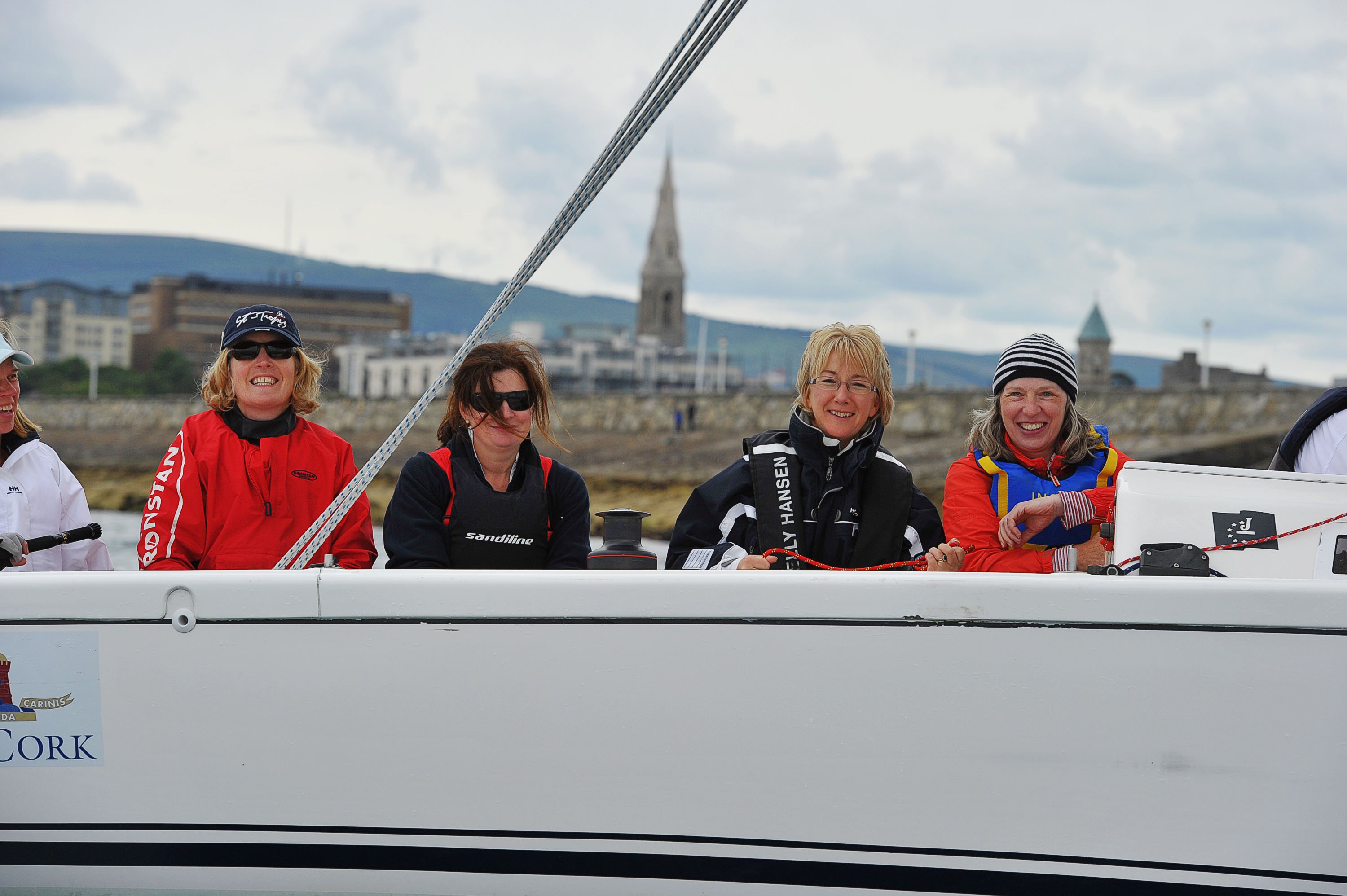

Three Races in Shorts and Shades in the J boats Cup
Thursday 3rd of June was the first day of racing at the J-Cup 2010, hosted by the Royal Southern Yacht Club in Hamble. The entry of 74 J Boats includes 27 J/109s which are racing for the 2010 J/109 UK National Championship title. The Principal Sponsors of the J-Cup 2010 are B&G, Dubarry of Ireland, North Sails and Universal Marina and each of them have staff sailing at the event. Conditions on the Solent yesterday were spot on; 6 to 15 knots from the South East and sparkling sunshine. The six class racing at the event, including the J/109s and each completed three races on the first day of the regatta.
Ian Matthews and his family team on board the J/122 Jinja dominated IRC 1 on the opening day with three straight wins, and achievement that earned Jinja the North sails Boat of the Day prize. Herman Bergshaven’s J/133 Solnes III, visiting the UK from Spain, had a great day, especially considering that the first time he had met most of his guest crew was at the preparatory signal for the first race. He sits in second place at the end of Day One and David Hunt’s J/122 Jacobs Ladder is currently lying third.
Eighteen J/80s are racing at the J-Cup 2010 and the fleet includes a number of new owners as well as two boats which are racing for the charity Toe In The Water. Steve Mittler’s young Team Baltic from Devon lead this one-design class with John Cooper’s Oi! just a point behind. Gordon Craigen, who took delivery of his J/80 Swallow just two weeks ago, is in third place. Team Baltic was named as the North Sails Boat of the Day but other notable results here include those of Brian Moreton who is racing the J/80 Juicy for the first time at this event. He is currently lying in an extremely creditable fourth place. Brian is more usually seen towards the front of the J/109 fleet in Juke Box.
North Sails Boat of the Day in IRC 2 is the J/97 Jika Jika, owned and raced by Mike and Jamie Holmes. Three wins yesterday for this team places them firmly at the top of the rankings at the end of Day One. Grant and Brigitte Gordon are in second place in their J/97 Fever Jr. This a great start for Fever Jr. especially when you consider that the J-Cup 2010 is her first regatta! In third is Mike Flood in his J/97 Indulgence, another brand new boat delivered just a few weeks ago. These J/97 guys clearly hit the water running and it will be interesting to see how each improves, race by race, over the next two days of the regatta.
Some of the closest ‘snakes and ladders’ racing yesterday took place in the J/105 Class with three different boats each winning a race. Rob Dornton-Duff’s Java took the bullet in Race One, the honours went to Richard Watney’s Jeopardy in Race Two and Race Three was won by William Newton and his crew on Jelly Baby. A 2,2,1 scoreline places Jelly Baby in pole position for the J/105 Class at the end of Day One and Jelly Baby was also selected as the North Sails Boat of the Day. Java lies second at the current time with Jeopardy in third place.
The fiercely competitive J/109 UK National Championship fleet were racing yesterday under the watchful gaze of a jury boat for the first time. The new J/109 Class Chairman, Adam Wright’s crew on board Velvet Elvis are right on the pace at the moment and three clear wins yesterday place them firmly at the top of the scoreboard. It also earned them the North Sails Boat of the Day prize. David and Kirsty Apthorp, who currently hold the J/109 UK National Championship title with their crew from J-Dream are second after the first day, David McLeman’s Offbeat is currently third overall, Stephen Tapper is fourth in Stalker and Matt Boyle’s Shiva is fifth as we go to press. The Race Committee for the J/109 fleet reported ‘the closest photo finish ever seen’ for Race Three, between Velvet Elvis and David Aisher’s Yeoman of Wight. We love that!
Three races are scheduled for Friday and conditions are forecast to be similar to the opening day, with sun and wind and hot competition throughout. If the J-Cup fleet didn’t quite manage to quench their thirst at the Universal Marina Opening Party after racing on Thursday, they can relax safe in the knowledge that they will return to shore later today to be entertained at the B&G ‘Dark & Stormy’ Party. Yippee!
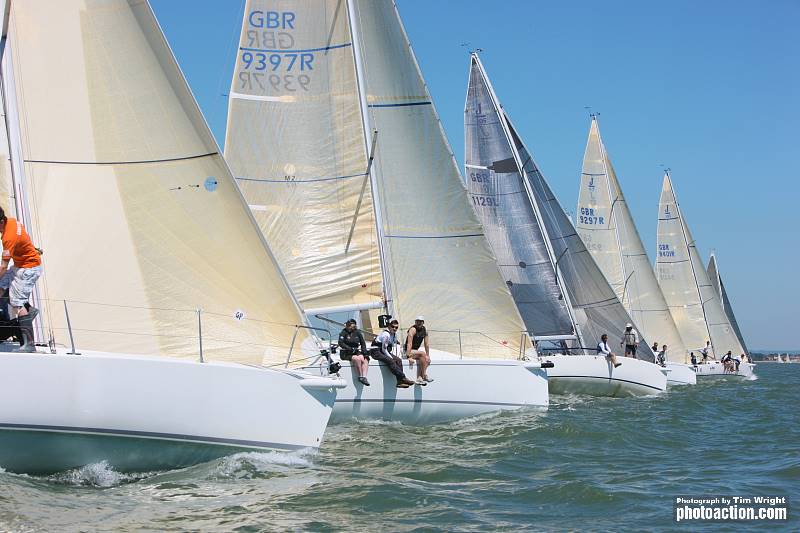
UK J80 Nationals Take Place on the Irish Sea
The Tacktick Suunto J/80 UK National Championship 2010 commences this week. The event will be hosted by the Cardiff Bay Yacht Club from Wednesday 5th May to Saturday 8th of May. Racing will take place in the Bristol Channel under the watchful eye of PRO David Cairncross and J/80 teams have travelled from all around the UK to comptete. The J/80 is the fastest selling sportsboat in Europe and the class is delighted that marine electronics specialists Tacktick Suunto are sponsoring the event. Ireland has 13 of these keelboats but sadly none are competing in Cardiff.
The competition in Cardiff will be hotly fought; alongside the travellers there will be a strong local field of five J/80 teams. J/80 International Class Chairman, Steve Cooper, will be competing in Junior High. Steve and his team are well travelled J/80 sailors and were part of the huge World Championship fleet at Santander last year. Local knowledge pays and we may see Junior High come of age this year. Scott Cole and his team on Purple Haze also from Cardiff, are known to be fast and both these boats know the sailing area well.
Toe In The Water, a charity that aims to encourage and rehabilitate injured servicemen and women through the sport of sailing, have four boats entered in the regatta. The relationship between the charity and the UK J/80 Class has been established for over three years now. Whilst these crews don’t get to sail with each other as frequently as many of the others at the Nationals, in the past the Toe In The Water teams have proved tactically strong and have shown skilful boat handling as well as pace.
The British Keelboat Academy will be represented at the Tacktick Suunto J/80 Nationals by Tom Phipps and Kelvin Matthews. These lads slotted in some really strong results at the championships in 2009 and will be well worth watching. The Britannia Royal Naval College will also be racing for the Championship title in J/80 Wave Warrior skippered by Joe Henry.
From the Solent, Thor Askeland makes his J/80 National Championship debut, racing Elle S’Apelle. Thor won the Autumn Champs in Hamble last year and has shown more than a few moments of brilliance throughout the spring season. He will be looking for consistency at the Nationals and for a podium finish. Terry Palmer (J/80 UK Class Chairman) and Caroline Cooper slotted in a top three result in the 93 boat J/80 fleet at Spi Ouest earlier this year, racing Just Do It. They will perhaps be hoping for similar windy conditions in Wales this week; they know they are quick in the big breeze. Ian Atkins will also be making the trip to Cardiff; having won five out of seven races sailed last weekend in his local series, Ian and his crew on Boats.com will have silverware their sights next week.
Racing at the Tacktick Suunto J/80 UK National Championship 2010 starts on Thursday. A full programme is planned on and off the water. It will be and extremely exciting and lively week!






























